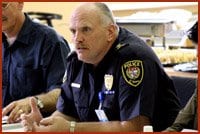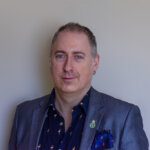Tales of police destroying outreach-issued crack pipe kits and harassing volunteers became the focus of a meeting when the Ottawa Police Service’s new chief met with reps of more than a dozen queer groups.
Meanwhile, the embattled Police Liaison Committee for the queer community used its time to praise the police for the progress they’ve made so far — rather than suggesting areas where policing could improve.
Vernon White, hired away from Durham regional police to become Ottawa’s new chief in May was affable and gregarious, making good natured jokes with the presenters at the Jul 10 meeting.
Right off the bat, the topic of harm reduction by way of needle exchange and safe inhalation (crack pipe) programs were brought to the fore. Representatives of AIDS Committee Of Ottawa and the Ottawa Coalition On HIV/AIDS let White know that harm reduction strategies were top of their agenda.
Ron Chaplin is the chair of the Ottawa Coalition On HIV/AIDS. With member organizations doing outreach in places including parks frequented for cruising, Chaplin is looking to remind the police of their work in the field.
“Every season, we must touch base with the police and make sure they understand when we’re doing what we’re doing, and what it is we’re doing,” Chaplin says. “So we don’t have the police [harassing] our outreach workers — because that has happened from time to time. We can usually work it out quite quickly, but most of these guys are volunteers and this is not pleasant. We have had in the past the active cooperation of the police department, but this is something that needs to be renewed constantly.”
Chaplin also sees HIV as a justice issue. “We understand who the bad guys are and who the victims are,” he says. “The people who are getting the crack pipes or the syringes are not the bad guys.”
Longtime activist Nathan Hauch also noted the importance of continuing the crack-pipe program and introducing a safe injection site in Ottawa.
“There’s lots of drug use in our community because of the closet,” he told Chief White. It’s wrong to frame the debate over harm reduction as one of morality versus health science. Instead, he says, “there’s a moral imperative to take a health-based approach.”
White replied that addiction is a medical issue. “We muddy the waters by making it a police issue,” he says. He has no issue with the medical side of the question, and suggested it is the primary job of police to put dealers in jail and users into treatment. Beyond that he is hesitant to offer an opinion.
“We don’t ask a doctor what they think of our police investigative techniques,” he says. Much of his discomfort discussing the issue, he said, stems from not wanting to give a “tool” to those who opposed harm reduction programs, allowing them to claim police opinion on their side.
White has been repeatedly quoted in mainstream media as opposing the crack pipe program. His predecessor, Chief Vince Bevan, wound up in a direct confrontation with city health employees over city-paid police officers breaking pipes that had been handed out, sometimes by city staff, and with city funds.
Earlier, White had committed to keeping an open mind about diversity issues, joking that retiring Deputy Chief Larry Hill, long popular in minority communities, is making sure of that.
While Chaplin seemed satisfied with White’s position, the AIDS Committee Of Ottawa’s Gay Men’s Outreach Coordinator, Nicholas Little, was more sceptical. “I don’t know if it was on purpose or not, but he said he views use of syringes for drugs as a medical issue and didn’t include crack kits in that,” Little said after the meeting. “What I’ve read of him in the paper is that he’s comfortable with the needle exchange — it’s the crack kit exchange that makes him less comfortable.”
White’s decision to reserve comment on crack kits as a medial issue better left to medical practitioners was seen by Little as a positive start.
But Little was more critical about the role of the police liaison committee to the gay community. Despite recent criticism about their lack of direction and their own admissions to being out of touch with Ottawa’s queer community, liaison committee members stayed largely silent Jul 10 — except when it came to applauding the police.
“What surprised me is that the police liaison committee chose this opportunity to really applaud and praise the police force,” Little says. It was a lost opportunity to call for the police to take on the sorts of issues raised by community members at the meeting — like harm reduction, youth isolation and prostitution.
Christopher Luesby, the retiring staff liaison to the committee, and himself a gay man, told the meeting he would not miss the public aspects of the job. But he will miss the comradeship of liaison meetings and interactions with the police themselves, he says. He found individual officers to be quick to wrap their heads around the intricacies of policing our community. And, he says, the steps made in recent years are proof that the police outreach to our community represents a substantial change in priorities and is “not just window dressing.”
But Little wonders “where praise and applause [was] for our own community and our efforts and our survival techniques in the face of oppression. It makes me wonder where, exactly, the priorities of the police liaison committee lie.”
In the shadow of a recent violent incident, hate crimes were raised at the meeting. White explained that neither the police, nor the community, sets the definition of a hate crime, though the Ottawa Police Service has perhaps the best hate-crime unit in Canada. The definition of hate crimes — and the way that police and the Crown deal with them — come from the Criminal Code, explains White.
Whether an incident is labelled a hate crime is something that usually takes place well into a police investigation, he says. And despite recent calls from the community for increased transparency about the details of an investigation, White says transparency is a touchy subject because of the need to protect a case from a mistrial in the event that an accused cannot get a fair trail, and also out of respect for the victim and the victim’s family.
White’s answer left Little wanting more — a commitment to be more pro-active in informing the community.
“My question was more about transparency and communicating with the queer community,” he says. “That when there’s fear and a certain degree of panic around certain incidents, that the police take steps to reassure us, and to also let us know if we are in danger.”
Organizer Jeremy Dias of Jer’s Vision is quick to point out White’s willingness to meet the community, despite only being on the job a few weeks.
“Not only does he meet with us, but he listens, he answers our questions, and he packed an entire room full of people,” Dias says. “The challenge wasn’t only in bringing the police chief out, it was also giving the community the opportunity to exercise their voice and we were really excited that the community took advantage of it.”
Dias calls the meeting an excellent first step. “I’m looking forward to steps two, three and four. At the end of the day, we really need our police chief to come out to our community.”
Video by Brent Creelman.


 Why you can trust Xtra
Why you can trust Xtra


